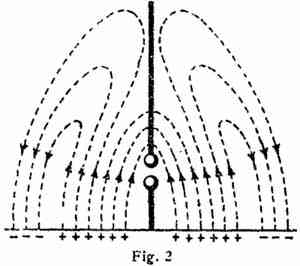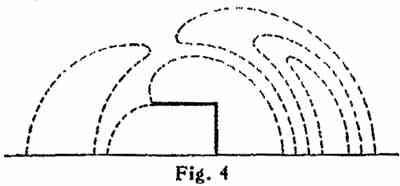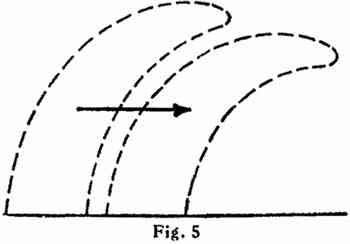
QST, №1, December, 1915
By Clarence D. Tuska, Assoc. I. R. E.
Many amateurs are proficient operators, but have only a vague idea of the theory of electro-magnetic waves. For example, you continually transmit Hertzian waves, but have you ever pictured what happens when you send a dash?
To explain the ether waves, let us consider a vertical aerial.

When the aerial is fully charged, the lines of strain leave the conductor at right angles to its surface. (Fig. 1.) Upon the discharge the upper ends of the strain lines rush down to meet the lower which move comparatively slowly as they pass along the earth. The earth offers more electrical resistance than the ether. When the upper ends of the strain lines reach the bottom of the aerial, the discharging current has reached its maximum, and as it reaches zero, it charges the aerial in the reverse direction as shown in Fig. 2. Therefore the new strains are formed with their feet on the earth. As the new strain reaches its maximum, the looped strain dies out, but loops are set up in the ether beyond. These loops are set up because when the electrical strain dies out, it sets up a magnetic strain. Upon the collapse of a magnetic strain, another electrical strain is set up in the opposite direction to those existing before, as in Fig. 3.

This action keeps repeating at its tremendous frequency and the waves are propagated at 300,000 kilometers per second. In practice we do not use the plain vertical aerial. The action being similar to Fig 4.

(Figs. 4 and 5 here).
Now we observe that the lead in is about the center of the wave action, showing the electro magnetic field is stronger on the lead in side. This gives us a theory for directive aerials. Upon the start of the waves, the peaks lean toward the aerial, but as the waves are propagated, their feet lag, owing to the resistance or impedence of the earth.

The peaks advance and approach receiving aerial as shown in Fig. 5. Now, if the transmitting aerial is slanting as shown in Fig. 4 with the lead at the higher end, the waves will point even more toward the sending aerial, but will reach the receiving aerial in a nearly vertical position. The nearer vertical, the waves reach the receiving aerial, the more energy they will impart to it.

By studying this important theory, we can see how mountains and oceans affect the waves. In crossing a mountain, the waves must pass over more ground at their feet in comparison with the peaks passing through the ether. This causes more lag than on level ground, and the peaks advance correspondingly. Naturally the waves reach the receiving antenna slanting more than if they had come over level ground and less energy is received. In passing over the water, the waves are propagated in a nearly vertical direction, as the water is a good conductor. It will be seen from this explanation, that many factors have been omitted, but enough has been given to form the basis of a more elaborate theory.